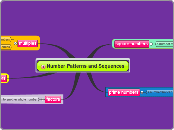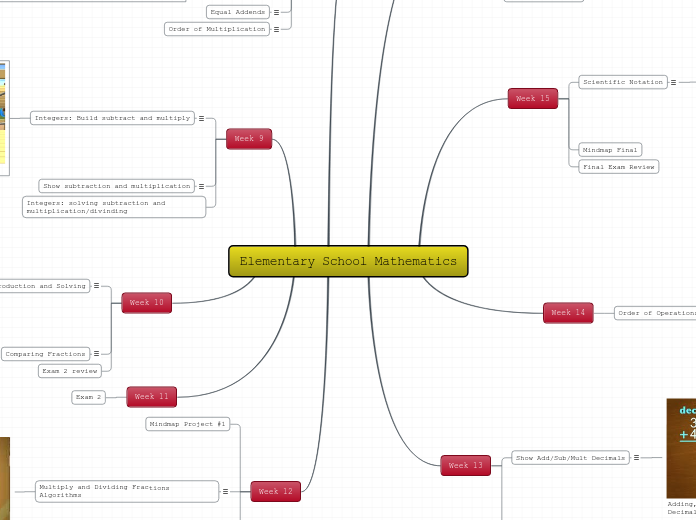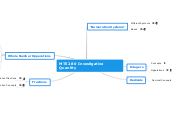MTE 280_Spring 2019
Weeks 8-15
Percentages
Mentally Calculating Percentages
- Example: What is 40% of 70?
- 10% of 70
- 10%= 7
- 10% x 4 = 7 x 4
- 40% = 28
Decimals
Decimals with Models
- Adding- Draw a box and divide them up according to the decimal. Shade in the amount the tenths or hundredth place reads then do the same for the other decimal being added. Add shaded parts together.
- 3.13 + 6.4= 9.53
- Subtracting- Draw a box. Shade in the amount the tenths or hundredth place reads. A second set of shading is used to show how much of the first is being subtracted.
- *Add zero for missing hundredths place
- 2.7 - 1.03= 1.67
- Multiplying- Draw one box. The first set of shading is labeled by the second set showing the how many individual boxes that are shaded are marked by the second shaded set.
- * Remove decimal and multiply numbers like you would multiply whole numbers. Multiple the whole numbers ONLY from the numbers being multiplied to know where to place decimal after multiplying
- 2.14 x 3.6= 7.704
Divisibility Rules
2- If the one's place has an even digit or zero then the number is divisible by 23- If the sum of all digits is divisible by three then the number is divisible by 34- If the ten's & one's are divisible by four then the number is divisible by 45- If the one's digit is a five or zero then the number is divisible by 56- If the number is even and the sum of all digits is divisible by two and three then the number is divisible by 68- If the last three digits are divisible by three then the number is divisible by 89- If the sum of all digits is divisible by nine then the number is divisible by 910- If the one's digit is a zeroSimilar Divisibility Groups2, 4, 82, 3, 63, 95, 10GEM/DA/S
- Order of operations - GEM/DA/S
- G
- Grouping
- E
- Exponents
- M/D
- Multiple/Divide
- A/S
- Add/Subtract
- *Groups can be separated with +/-
Weeks 4-6
Properties of Mathematics
Associative
- Grouping different numbers together
Ex: (3+4)+7=3(4+7)
Commutative
Ex: 3+4+7=3+7+4
Distributive
- Multiplying a number by every number in the parentheses
Ex: 3(6+4)= 3(6)+3(4)
18+12=30
Alternative Practices
Multiplication
Area Model
- Calculating the area of a square
- units, longs, etc. are separated to solve multiplication
Ex: (34)(68)=(30+4) and (60+8)
30x60=1800
30x8=240
4x60=240
4x8=32
1800+240+240+32=2,312
- Designed to multiply each individual digit by the other
- Sized to fit the numbers being multiplied (box)
- The multiplicand is placed along the top of the lattice so that each digit is the header for one column of cells; the multiplier is placed along the right side of the lattice so that each digit is a header for one row of cells
- Numbers of products are added diagonally
- Answer is read from left to right
Ex: (34)(56)
3x7=21
4x7=28
3x8=24
4x8=32
Add diagonally in diagram= 3,354
- Separate the units, longs, etc, much like the area model then set numbers vertically like traditional multiplication algorithm
- Multiply numbers separately
- Add products together to determine answer
Ex: (34)(68)=(30+4)x(60+8)
30x60=1800
30x8=240
60x4=240
8x4=32
1800+240+240+32=2,312
Addition
Trading Off
- Similar to Friendly Numbers
- Change one number to be a factor of ten or in base ten
- Add numbers vertically
Ex: 48+27
(48+2)+(27-2)
50+25=75
Friendly Numbers
- Change one number to be a factor of ten
- Subtract from one number then add to other
- Add
Ex: 38+12 = (38+2)+(12-2)
40+10=50
Left to Right
- Keep digits of numbers separate
- Add each place value separately
- Add final numbers.
Ex: 35+12=30+5+10+2
40+7=47
Lattice
- Add numbers vertically like traditional algorithm
- Add sums diagonally
- Answer is read left to right
Ex: 256+138
6+8=14
5+3=8
2+1=3
Add digits diagonally= 394
Expanded Form
- Separate the units, longs, etc, much like the area model then set numbers vertically like traditional addition algorithm
- add numbers separately
- Add sums together to determine answer
Ex: 315+216=(300+10+5)+(220+10+6)
300+220=520
10+10=20
5+6=11
520+20+11=531
Scratch Method
- Numbers can be added vertically or horizontally
- Eliminate digits as the base value has been reached
- Add with each scratch representing a base value then carry remainders
Ex: 3+2+1+4+6+2+3+4+2 Base eight
3+2+1+4=10 SCRATCH 4 with remainder 2
2+6=0 SCRATCH 6 with remainder 0
2+3+4=9 SCRATCH 9 with remainder 1
1+2=3 Carry ALL SCRATCHES over to next place value
Answer= 33 Base eight
Weeks 7-10
Fractions
Fractions with Models
- Adding- Draw two boxes and divide them up according to the fraction. Shade in the amount the numerator reads. Draw a third box then use it to show how many individual spaces are shading both original models
- 2/3 + 1/2= 1 1/6
- Subtracting- Draw two boxes. A second set of shading is used to show how much of the first is being subtracted.
- 3/4 - 1/5= 11/20
- Multiplying- One box is used to. The firsts set of shading is labeled by the second set showing the how many individual boxes that are shaded are marked by the second shaded set.
- 1/3(2/5)=2/15
How do Fractions work?
- Fractions must have like denominators so only the numerators are added or subtracted when adding or subtracting fractions.
- Denominators do not need to be the same when multiplying fractions
Numerator/Denominator
- Numerator: represents what you have ( how many pieces)
- denominator: represents the size of the pieces of a whole
Factoring
Prime/Composite Numbers
- One is neither prime or composite
- Composite Numbers
- Numbers with more than two factors
- 4, 6, 8, 9, 10
- Prime Numbers
- Numbers that only have two factors
- 2, 3, 5, 7, 11
Prime Factorization
- Factors of a specific number
- Methods:
- Factor Tree
- 18= 2*9, 9=3*3
- factors: 2 and 3
- Prime factorization: 2*32
- Upside Down L Division
- 20= 20/2=10/2=5
- factors: 2 and 5
- Prime factorization: 22*5
- GCF= 2
- LCM= 22*32*5
Least Common Multiple
- The greatest number that two or more numbers are divisible by.
- Use greatest exponents for individual numbers
- 18= 2*32
- 20=22*5
- LCM=22*32*5
Greatest Common Factor
- Smallest number that goes into two or more numbers
- Use smallest exponents for individual numbers
- 18= 2*32
- 20=22*5
- GCF=2
Drawing Manipulative/Integers
- Numbers are represented with a + or - depending if the number is positive or negative.
- A pair of a positive and a negative is a zero pair. A collection of zero pairs is a zero bank.
- Can have an unlimited amount of zero pairs as needed
- Negative is different from Subtracting/taking away
- Separate numbers into groups and units when multiplying integers
- The groups contain a number of positives/negatives
- Take away groups of units for negative numbers
Multiplying Integers
- 2(2)= (++) + (++)
- Two groups of two positives
- Answer= 4
- -3(-2)= (++(--) -->) + (++(--) -->) +(++(--) -->)
- Take away three groups of two negatives
- Only positives are left
- Answer= 6
Subtracting Integers
- (-3)-4= (---) - (++++----)
- Take away the one positive created by the zero bank
- (++++) -->
- Seven negatives are left
- Answer=-7
- (-3)-(-1)= (---) - (-)
- Take away one negative (-) -->
- Answer= -2
Adding Integers
- 3+(-2)=(+++)+(--)
- 2 positives and 2 negatives create a zero bank
- One negative is left over
- Answer= -1
- (-1)+(-1)= (-)+(-)
- Add negative together
- Answer= -2
Weeks 1-3
Converting Bases
Converting from Base Ten
- Use Downward Division
- Divide the given number by the Base number
- Ex: 24 to Base five = 24 \ 5 = 4 with a remainder of 4, so answer equals 44 base five
- Ex: 64 to Base seven = 64 \ 7 = 9 remainder 1; converting to Base seven, the 7 must be converted to a flat, so the answer equals 121 base seven
*Remember any digit in a number cannot equal or exceed the number of the base.
Converting to Base Ten
- Determine the number of units in a given number
- Multiply the number of Longs by the Base, then add the Units
Ex: 23 Base five = 2(5) + 3 = 13
Ex: 302 Base four = 3(16) + 0(4) + 2 = 50
Labeling Manipulatives
- Units
- The number of an individual unit
- Longs
- A group of units that are determined by the Base
(Ex: 10 Base five = five units equals a long)
- Flats
- A group of longs that is also determined by the Base (Ex: 100 Base five = five longs made up of five units per flat)
*If there is no written base, it is in base 10
*Whatever fits in a long names the base
*Any digit in a number cannot equal or exceed the number of the base.
Standards of Math Practice
- Make sense of problem and PERSERVERE
- Reason Abstractly/Quantitatively
- Construct Viable Arguments
- Use Appropriate Tools
- Look for & make sense of Structure
- Look for Repeated Reasoning
- Model
- Attend to Precision
Problem Solving Strategies
- Look for a Pattern
- Do a Similar/Easier Problem
- Identify What Makes the Problem Hard. Remove the Hard part.
- Draw a Diagram (Not a Pic)
- Guess and Check!
- Write an Equation
UnDev CarLO
Four Step Solving Process:
- Un- Understand
- Dev- Develop plan
- Car- Carry out plan
- LO- Look back









